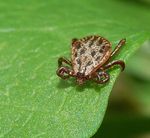Difference between revisions of "Dermacentor spp."
m (Text replace - "Category:To_Do_-_NickJ" to "") |
|||
| Line 38: | Line 38: | ||
| − | [[Category:Hard_Ticks_-_UK | + | [[Category:Hard_Ticks_-_UK]][[Category:Expert_Review]] |
Revision as of 23:22, 9 October 2010
| This article has been peer reviewed but is awaiting expert review. If you would like to help with this, please see more information about expert reviewing. |
| Dermacentor spp. | |
|---|---|
| Kingdom | Animalia |
| Phylum | Arthropoda |
| Class | Arachnida |
| Sub-class | Acari |
| Super-order | Parasitiformes |
| Order | Ixodida |
| Super-family | Ixodidea |
| Family | Ixodidae |
| Genus | Dermacentor |
| Species | Many |
Dermacentor spp. of ticks can be identified by;
- Wide palps
- Rectangular base of capitulum
- Eyes
- Ornate
- Posterior anal groove
- Festoons on the posterior margin
There are two species found in the UK and Europe D.reticulatus and D.marginatus, the ornate sheep tick however this is absent from the UK. D.reticulatus is a three host tick found on meadows, pastures and forests in England and Wales. Adults will parasitise large mammals whilst larval and nymphal stages attack small mammals, insectivores and sometimes birds. The tick is known to transmit a number of disease in man and and veterinary species. D.reticulatus is responsible for transmitting Babesia canis in dogs, B.divergens and B.ovisin cattle as well as Q fever (C.burnetti), tularemia, Brucella, Anaplasma ovis and Rickettsia conorii the cause of Boutonneuse fever. In horse D.reticulatus is responsible for the transmission of Babesia caballi and B.equi.
Literature Search
Use these links to find recent scientific publications via CAB Abstracts (log in required unless accessing from a subscribing organisation).
Dermacentor publications since 2000

